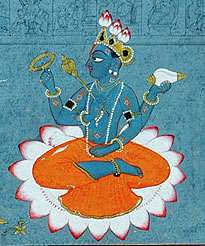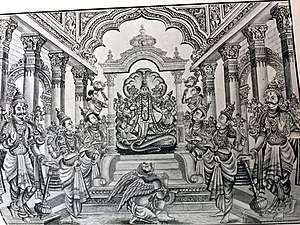Vaikuntha
Vaikuntha (Sanskrit: वैकुण्ठ, Vaikuṇṭha), Vaikuntha Loka, Vishnuloka, Paramam padam, Nitya Vibhuti, Thirupparamapadham or Vaikuntha Sagara[1] is the celestial abode (dwelling) of Vishnu who is the principal deity of the Universes and known to be Godhead, as revered by all of pre-Battle Of Kurukshetra,[2] and the supreme being in Vedic, Hinduism, and its Vaishnavism traditions.[3][4]

.jpg)
Vaikuntha is an abode presided over on high exclusively by him, accompanied always by his feminine partner, consort and goddess Lakshmi, According to Ramanuja, Parama padam or Nitya Vibhuti is an eternal heavenly realm and is the divine imperishable world that is the God's abode. It is the highest state beyond all worlds and nothing else beyond it. It is guarded by the twin deities, Jaya and Vijaya (guardians of Vishnu's realm).[1] The Vaikuntha planets are full of golden palaces and hanging gardens that grow fragrant sweet scented fruits and flowers
The Vaikuṇṭha planets begin 26,200,000 yojanas (209,600,000 miles) above Satyaloka.[5] In most of the extant Puranas and Vaishnava traditions, Vaikuntha is located in the direction of the Makara Rashi which coincides with the constellation of Capricorn. One version of the cosmology states that Vishnu's eye is at the South Celestial Pole from where he watches the cosmos.[6]
In Rigveda
tad viṣṇoḥ paramaṁ padaṁ sadā paśyanti sūrayaḥ |
The gods are always looking to that supreme abode of Lord Vishnu |
| —Rigveda (1.22.20) |
In Bhagavata Purana

In the Bhagavata, the text speaks of Vaikuntha, adorable to all the worlds (X.12.26), as the highest realm where Vishnu resides (XII.24.14). This, too, is the highest region (IV.12.26); beyond the world of darkness and samsāra (the cycle of birth and death) (IV.24.29; X.88.25); the destination of those who have transcended the three Gunas even while they are still alive (XI.25.22); and beyond which there is no higher place (II.2.18, II.9.9). The peaceful ascetics who reach that place never return (IV.9.29; X.88.25-6). The residents of Vaikuntha do not have material bodies, but have pure forms (VII.1.34). These forms are like that of Vishnu (III.15.14ff.), also known as Narayana. Vishnu/Narayana resides in Vaikuntha with Sri, the goddess of fortune, in palaces with crystal walls. The parks there shine like final liberation itself, and contain wish-fulfilling trees, which blossom all the year round. There are fragrant winds, and creepers dripping with honey near bodies of water. Cries of exotic birds mingle with the humming of bees, and magnificent flowers bloom everywhere. Devotees of Vishnu along with their beautiful wives travel in aerial vehicles made of jewels, emeralds and gold, but the beautiful smiling residents of this realm cannot distract the minds of the opposite sex, since everyone is absorbed in Krishna (III.15.14-25).[9]
The Lord, being thus very much satisfied with the penance of Lord Brahma, was pleased to manifest His personal abode, Vaikuntha, the supreme planet above all others. This transcendental abode of the Lord is adored by all self-realized persons freed from all kinds of miseries and fear of illusory existence. (BP 2.9.9)
In that personal abode of the Lord, the material modes of ignorance and passion do not prevail, nor is there any of their influence in goodness. There is no predominance of the influence of time, so what to speak of the illusory, external energy; it cannot enter that region. Without discrimination, both the demigods and the demons worship the Supreme Lord as devotees. (BP 2.9.10)
The inhabitants of the Vaikuntha planets are described as having a glowing sky-bluish complexion. Their eyes resemble lotus flowers, their dress is of yellowish color, and their bodily features very attractive. They are just the age of growing youths, they all have four hands, they are all nicely decorated with pearl necklaces with ornamental medallions, and they all appear to be effulgent. (BP 2.9.11)
Some of them are effulgent like coral and diamonds in complexion and have garlands on their heads, blooming like lotus flowers, and some wear earrings. (BP 2.9.12)
The Vaikuntha planets are also surrounded by various airplanes, all glowing and brilliantly situated. These airplanes belong to the great mahatmas or devotees of the Lord. The ladies are as beautiful as lightning because of their celestial complexions, and all these combined together appear just like the sky decorated with both clouds and lightning. (BP 2.9.13)
The goddess of fortune, Lakshmi in her transcendental form is engaged in the loving service of the Lord's lotus feet, and being moved by the black bees, followers of spring, she is not only engaged in variegated pleasure—service to the Lord, along with her constant companions—but is also engaged in singing the glories of the Lord's activities. (BP 2.9.14)
Lord Brahma saw in the Vaikuntha, Narayana, who is the Lord of the entire devotee community, the Lord of the goddess of fortune, the Lord of all sacrifices, and the Lord of the universe, and who is served by the foremost servitors like Nanda, Sunanda, Prabala and Arhana, His immediate associates. (BP 2.9.15)
The Lord, seen leaning favorably towards His loving servitors, His very sight intoxicating and attractive, appeared to be very much satisfied. He had a smiling face decorated with an enchanting reddish hue. He was dressed in yellow robes and wore earrings and a helmet on his head. He had four hands, and His chest was marked with the lines of the goddess of fortune. (BP 2.9.16)
The Lord was seated on His throne and was surrounded by different energies like the four, the sixteen, the five, and the six natural opulence, along with other insignificant energies of the temporary character. But He was the factual Supreme Lord, enjoying his own abode. (BP 2.9.17) it is also said that Vaikuntha is the liberated world or the world after moksha
See also
References
- Ramesh M. Dave, K. K. A. Venkatachari, Śyā. Go Mudgala, Bochasanvasi Shri Aksharpurushottama Sanstha. The bhakta-bhagawan relationship: paramabhakta parmeshwara sambandha : a collection of essays presented in the "Bhakta-Bhagawan Relationship Conference" organised as part of the Aksharbrahman Gunatitanand Swami bicenten[n]ial celebrations, Amdavad, 1985. p. 158.CS1 maint: multiple names: authors list (link)
- Maehle, Gregor (2012). Ashtanga Yoga The Intermediate Series: Mythology, Anatomy, and Practice. New World Library. p. 207. ISBN 9781577319870.
Vaikuntha (Vishnu's celestial home)
- Orlando O. Espín; James B. Nickoloff (2007). An Introductory Dictionary of Theology and Religious Studies. Liturgical Press. p. 539. ISBN 978-0-8146-5856-7.
- Gavin Flood, An Introduction to Hinduism (1996), p. 17.
- Śrīmad Bhāgavatam 5.23.9,
The Vaikuntha planets begin 26,200,000 yojanas (209,600,000 miles) above Satyaloka.
- White, David Gordon (2010-07-15). "Sinister Yogis": 273 with footnote 47. ISBN 978-0-226-89515-4. Cite journal requires
|journal=(help) - Śrīmad-Bhāgavatam: With a Short Life Sketch of Lord Śrī Caitanya Mahāprabhu, the Ideal Preacher of Bhāgavata-dharma, and the Original Sanskrit Text, Its Roman Transliteration, Synonyms, Translation and Elaborate Purports 11, Part 4.
- Rigveda (1.22.20)
- Krishna: The Beautiful Legend of God: Srimad Bhagavata Purana|url=https://books.google.com/books?id=y8Bb0tRW7W4C&pg=PT38&dq=krishna+vaikuntha&hl=en&sa=X&ved=0ahUKEwiUzoma-JjUAhUKM48KHUsCChY4FBDoAQgfMAE#v=onepage&q=krishna%20vaikuntha&f=false
Bibliography
- Dallapiccola, Anna. Dictionary of Hindu Lore and Legend. ISBN 0-500-51088-1.
- Gail, Adalbert J. 1983. "On the Symbolism of Three- and Four-Faced Vishnu Images: A Reconsideration of Evidence." Artibus Asiae 44(4):297–307. pp. 298–99.